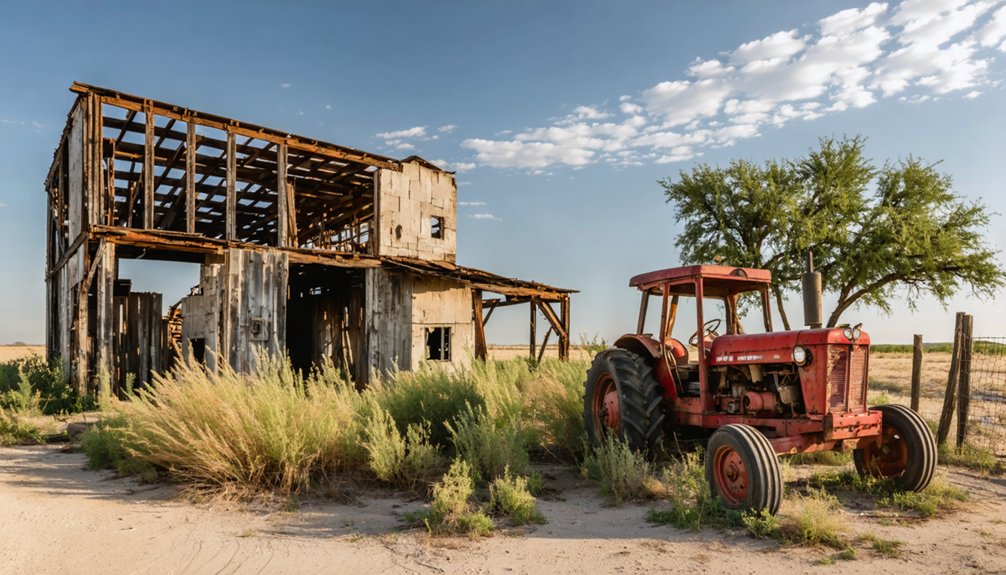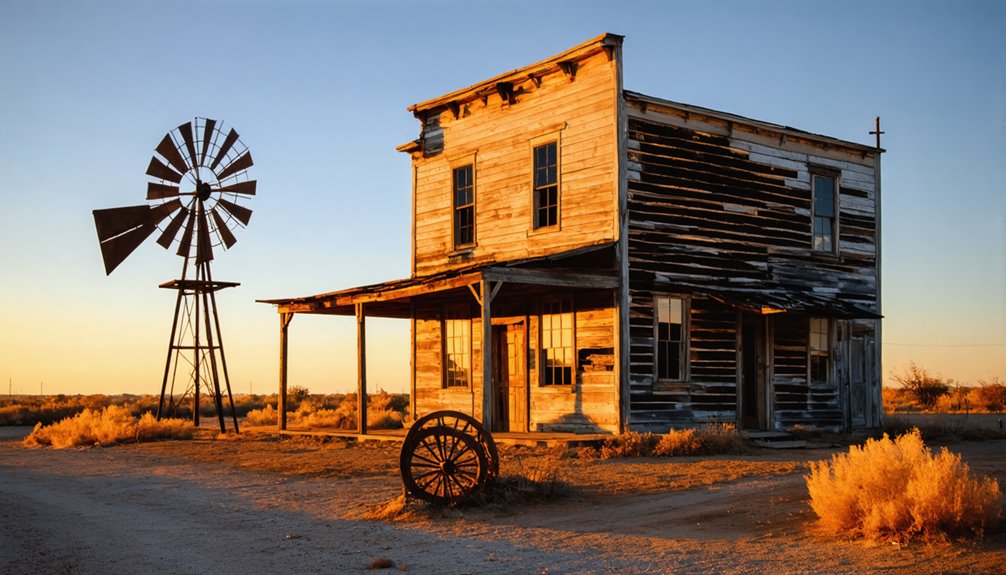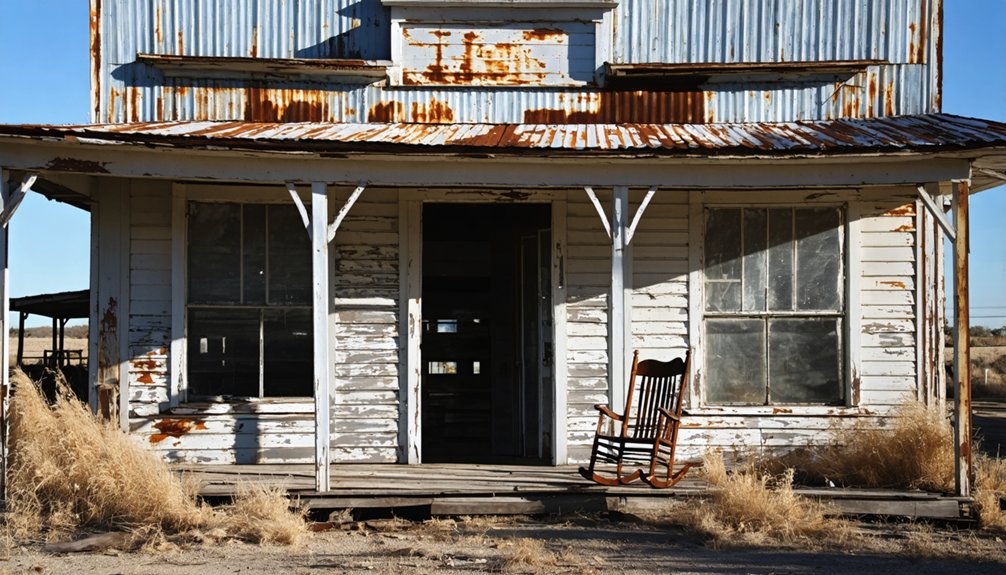You’ll find Hickory Flats beneath the waters of Lewisville Lake in Denton County, Texas. This former pioneer settlement began with John Maloney’s 640-acre land grant in 1833, serving as a crucial crossroads for Texas Rangers and early settlers. The community later thrived around coal mining operations, drawing immigrants from Italy, Poland, Britain, and Ireland. While its buildings now lie submerged, Hickory Flats’ rich history of agriculture, mining, and frontier life offers fascinating glimpses into Texas’ rural past.
Key Takeaways
- Hickory Flats was a small farming community in Denton County that now lies submerged beneath Lewisville Lake.
- The town developed around coal mining operations in 1886, attracting immigrants from Italy, Poland, Britain, and Ireland.
- Agricultural decline, limited transportation infrastructure, and lack of railroads contributed to the town’s eventual abandonment.
- The community never exceeded 100 residents and gradually transformed into a ghost town due to economic shifts and rural migration.
- Deteriorating structures and scattered ruins are all that remain, though local historical commissions work to preserve the town’s memory.
The Search for Hickory Flats
Where exactly did the once-thriving community of Hickory Flats stand?
Today, you’ll find its forgotten landmarks submerged beneath Lewisville Lake, roughly three miles southeast of Denton, Texas. The historical significance of this ghost town lives on through maps from the 1880s, which show “Hickory” positioned near what’s now Hickory Creek Park in Denton County.
The ghost town of Hickory Flats rests silently underwater, its remains hidden beneath Lewisville Lake near modern-day Hickory Creek Park.
You can trace the settlement’s footprint along old roads that once connected it to Dallas, crossing farm lands and fording Elm Creek. John Maloney’s land grant of 640 acres formed a key part of the early settlement in 1833.
Like many Texas settlements of its era, the town’s fate was sealed when Texas Rangers were called in to maintain order during heated disputes with neighboring communities.
While modern development has obscured most physical traces, historians and researchers are using GIS technology, historical records, and local oral histories to piece together its location.
The site served as a vital crossroads for Texas Rangers and settlers in the mid-1800s, marking its importance in frontier history.
Early Settlement and Pioneer Life
Before Anglo-American settlers established Hickory Flats, indigenous peoples had called this fertile region home for millennia, including the Lipan Apache who roamed the area in the 1500s. Spanish explorers passed through in the 1700s, naming the Pedernales River for its abundant flint rock.
When pioneer families arrived in the 1840s, they faced immediate challenges establishing their homesteads. You’d find them building log cabins on ridge tops for natural drainage and protection from floods. The settlers constructed homes with two large rooms and traditional mud chimneys.
They cleared small plots for early agriculture, fencing them with rails to keep livestock in check. As the community grew, they developed essential infrastructure – cotton gins, gristmills, and general stores. These pioneers understood the importance of preserving records of their settlement’s growth for future generations.
Both free and enslaved African Americans contributed to the settlement’s development, later establishing their own schools and churches, including the Hickory School in 1877.
Community Development and Growth
You’ll find the early settlement of Hickory Flats took shape around the coal mining operations that began in late 1886 under the leadership of William Whipple Johnson and Harvey Johnson.
As mining activities expanded, you’d have witnessed the influx of immigrants from Italy, Poland, Britain, and Ireland who brought their families and established roots in this controlled industrial community. Similar to other towns in the region, a one-room school was constructed to serve the growing population.
The town’s growth remained closely tied to its mining operations, with the population expanding within the confines of a fenced, company-regulated settlement that balanced industrial needs with residential life. The company maintained strict control through armed guards patrolling to prevent unauthorized access and keep union organizers away.
Early Settlement Patterns
As pioneers sought promising locations for settlement in North Texas, the confluence of Hickory Creek and its tributaries emerged as an ideal site for what would become Hickory Flats.
Pioneer motivations centered on the area’s rich natural resources, including abundant water, timber, and dark clay soil perfect for farming. You’ll find their settlement strategies were carefully calculated – they chose locations near natural springs and fertile creek bottoms that could support diverse activities from hunting to agriculture. Similar to the French Settlement established in 1852, settlers gravitated toward the strategic location at creek forks. Like the impresario system that had previously encouraged settlement, the area’s natural advantages drew families seeking new opportunities.
After the removal of eastern Native American tribes, settlers established roots in the timbered creek regions.
The area’s potential for mixed-use activities proved essential for community survival, with early settlers balancing farming with timber harvesting. These strategic choices laid the groundwork for a thriving frontier community.
Population Growth Timeline
While many Texas ghost towns experienced dramatic population booms and busts, Hickory Flats maintained consistently modest numbers throughout its history.
Similar to mining camp Terlingua’s peak during World War I, Hickory Flats never achieved significant growth or economic importance.
You’ll find that population stability characterized this small Texas community, which never developed the explosive growth seen in neighboring mining or railroad towns.
The demographic trends reveal a town that remained remarkably unchanged:
- Unlike other ghost towns that peaked with hundreds or thousands of residents, Hickory Flats maintained a small, stable population through the 20th century.
- Mid-1900s brought no significant changes, as the town missed out on industrial and wartime economic booms.
- By 2000, the population remained under 100 residents, with limited infrastructure and no major revitalization efforts.
Like nearby Frost and Dawson which saw peaks of 913 and 1,155 residents respectively, Hickory Flats struggled to maintain its population over time.
The town’s story reflects a different path than the typical boom-and-bust cycle of many Texas ghost towns.
The Rise and Fall of Rural Texas
You’ll find that Hickory Flats, like many rural Texas communities, emerged in the 1840s as settlers established farms and ranches along early transportation routes.
Your ancestors might’ve witnessed the town’s growth through the 1870s, when agricultural opportunities and essential services drew diverse immigrant populations to the area.
Settlement to Abandonment
During the late 1800s, Hickory Flats emerged as a rural settlement in Bastrop County, Texas, nestled near the intersection of what would become Farm Road 812, Watts, and Lytton Springs Road.
The community drew its name from the abundant hickory trees that once dominated the landscape, supporting a lifestyle centered on farming and local resources.
You’ll find that three main factors contributed to the community’s eventual decline:
- Limited transportation infrastructure, with only basic 2WD farm roads connecting to nearby towns
- The absence of railroad connections that could have stimulated commerce and growth
- Economic shifts and rural migration that led to population loss as agricultural mechanization reduced the need for farm workers
The settlement’s fate was sealed by these challenges, transforming it from a vibrant farming community into a ghost town.
Farm Life Fades Away
As Texas farmland disappeared at an alarming rate between 2017-2022, the story of Hickory Flats became increasingly familiar across the state’s rural landscape.
You’d have witnessed more than 17,700 farms vanish alongside 1.6 million acres of agricultural land, while aging farmers found fewer young hands willing to carry on their legacy.
The march of farm consolidation changed everything you once knew about places like Hickory Flats.
Where independent family farms once dotted the countryside, massive operations now stretch across thousands of acres.
Rural depopulation hit hard as your neighbors’ children sought opportunities in cities, leaving behind empty homesteads and silent fields.
Despite impressive technological advances that boosted production, you can’t help but notice how the tight-knit farming community that defined Hickory Flats has slowly unraveled.
Agricultural Heritage and Local Economy

Three key agricultural activities shaped Hickory Flats’ economic landscape throughout its history: livestock farming, cotton production, and later, poultry operations.
You’d find sustainable farming practices deeply woven into the community’s fabric, where families practiced self-sufficiency through vegetable gardens, fruit trees, and livestock management.
- Until the 1950s, nearly every family owned cows for milk and butter, often using these products for bartering during tough times like the Great Depression.
- Cotton dominated as the primary cash crop until the 1940s, when the local gin’s destruction marked a turning point.
- The shift to poultry farming followed regional trends, though overproduction eventually forced independent farmers to sell to larger corporations.
This agricultural evolution reflects the community’s resilience and ability to adapt as economic conditions changed.
Remnants and Ruins Today
Today in Hickory Flats, you’ll find a haunting collection of deteriorating structures that tell the story of this once-vibrant Texas community.
As you explore the ruins, you’ll discover roofless buildings and scattered remnants slowly blending into the Texas plains. Unlike other ghost towns with dedicated preservation efforts, Hickory Flats stands largely forgotten, its historical significance marked only by crumbling foundations and building debris.
The site’s ruins exploration potential attracts photographers and history enthusiasts, though you’ll need local knowledge to locate specific areas, as formal markers are scarce.
While some structures remain standing, they’re mostly abandoned and continue to deteriorate under harsh weather conditions. Without an active historical society or museum, these physical remnants serve as the last carbon-dating witnesses to Hickory Flats’ frontier era.
Tales From the Texas Frontier

The tales of Hickory Flats stretch back to its earliest days as a frontier outpost, where rangers and settlers carved out their existence along the dusty trails of 1840s Texas.
You’ll find stories of frontier justice woven into the settlement’s fabric, including the county’s first recorded murder when ranger Teel shot Ramsey in 1848.
Early transportation routes through Hickory Station linked the community to Dallas and beyond, creating an essential lifeline for both commerce and communication.
- Rangers patrolled these routes regularly, maintaining order in the untamed territory
- African American families established deep roots here after the Civil War
- The settlement served as a significant waypoint for travelers, connecting smaller farms to larger economic networks
Preserving Ghost Town History
Preserving Hickory Flats’ history requires careful documentation and dedicated community involvement to guarantee its stories endure for future generations.
You’ll find preservation groups working to capture oral histories, collect vintage photographs, and maintain detailed records of the town’s significant events and personalities.
Local historical commissions play an essential role in ghost town preservation, installing interpretive markers and creating museum displays that tell Hickory Flats’ unique story.
They’re working to clarify property titles and navigate complex zoning regulations that impact restoration efforts.
You can support these initiatives by participating in community events, sharing family records, or joining local heritage tourism programs.
Through video histories, archival documentation, and ongoing maintenance of original structures, you’re helping ensure that Hickory Flats’ legacy remains alive for curious minds to explore and understand.
Frequently Asked Questions
Were There Any Native American Settlements Near Hickory Flats Before Pioneer Settlement?
You’ll find evidence of Native American tribes near your area, including the Caddo and Comanche peoples. Historical artifacts like Scallorn points and pottery fragments confirm their settlements before pioneers arrived.
What Natural Disasters or Epidemics Affected the Population of Hickory Flats?
You won’t find documented disease outbreaks or natural disasters for this community. While Texas towns often faced drought impact and epidemics, no specific records show these affecting this settlement.
Did Any Famous Outlaws or Historical Figures Pass Through Hickory Flats?
You won’t find evidence of famous outlaws or widely-known historical figures in Hickory Flats, though Texas Rangers did frequent the area’s Hickory Station, where Ranger Teel killed Mr. Ramsey in 1848.
What Was the Peak Population of Hickory Flats During Its Existence?
Like many rural settlements that rode the winds of change, you’ll find population trends suggest a modest peak of fewer than 200 residents, though demographic shifts gradually reduced this frontier community to ghost town status.
Were There Any Local Legends or Folklore Specific to Hickory Flats?
While you might hear tales of ghostly apparitions in nearby Texas towns, there aren’t any documented haunted tales or specific folklore connected to Hickory Flats in historical or community records.
References
- https://theforgottensouth.com/cheapside-texas-ghost-town-history/
- https://www.redriverhistorian.com/post/forgotten-hickory-at-hickory-creek-in-denton-county
- https://www.youtube.com/watch?v=phjUE19A8HM
- https://texashighways.com/travel-news/four-texas-ghost-towns/
- https://www.southernthing.com/ruins-in-texas-2640914879.html
- https://en.wikipedia.org/wiki/List_of_ghost_towns_in_Texas
- https://www.ghosttowns.com/states/tx/hickoryflats.html
- https://www.redriverhistorian.com/ghost-towns
- https://mix941kmxj.com/see-how-two-texas-ghost-towns-battled-for-the-county-and-lost/
- https://tpwd.texas.gov/publications/pwdpubs/media/pwd_bk_p4507_0026m.pdf



